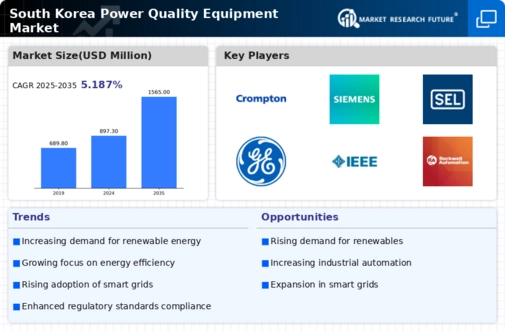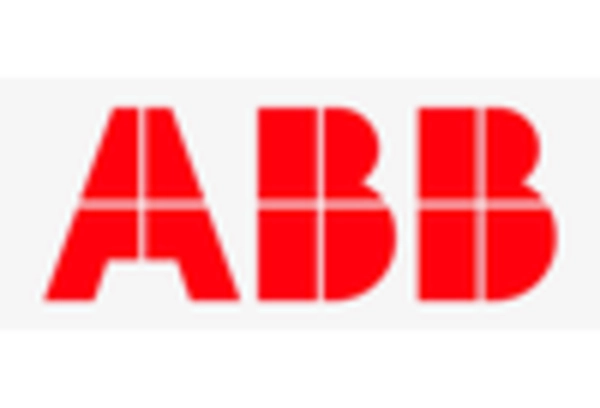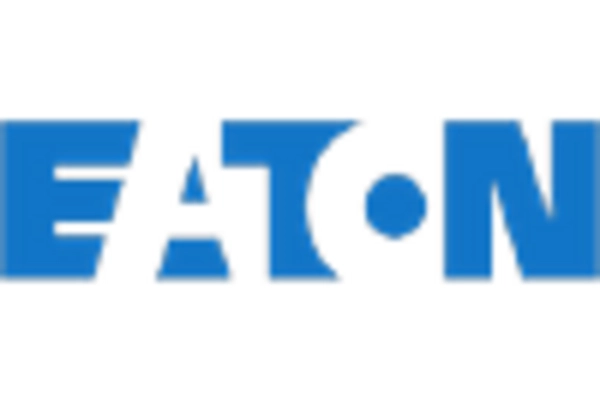Rising Industrial Demand
The power quality equipment market in South Korea is experiencing a surge in demand driven by the industrial sector. As industries increasingly rely on sensitive electronic equipment, the need for reliable power quality solutions becomes paramount. In 2025, the industrial sector is projected to account for approximately 40% of the total market share, highlighting the critical role of power quality in maintaining operational efficiency. This demand is further fueled by the expansion of manufacturing facilities and the adoption of automation technologies. Industries such as semiconductor manufacturing and automotive production are particularly sensitive to power disturbances, necessitating advanced power quality equipment to mitigate risks. Consequently, the growth of these sectors is likely to propel the power quality-equipment market forward, as companies seek to enhance productivity and reduce downtime caused by power quality issues.
Technological Advancements
Technological advancements are significantly influencing the power quality-equipment market in South Korea. Innovations in power electronics, such as the development of advanced filters and power conditioning devices, are enhancing the efficiency and effectiveness of power quality solutions. In 2025, the market is expected to witness a compound annual growth rate (CAGR) of around 8%, driven by these technological improvements. Furthermore, the integration of Internet of Things (IoT) capabilities into power quality equipment allows for real-time monitoring and data analytics, enabling proactive management of power quality issues. This trend not only improves system reliability but also reduces operational costs for businesses. As companies increasingly prioritize energy efficiency and sustainability, the demand for technologically advanced power quality solutions is likely to rise, further propelling the market's growth.
Growing Data Center Infrastructure
The expansion of data center infrastructure in South Korea is emerging as a vital driver for the power quality-equipment market. With the increasing reliance on digital services and cloud computing, data centers require robust power quality solutions to ensure uninterrupted operations. In 2025, the data center sector is projected to contribute significantly to the overall market, as companies invest in power quality equipment to safeguard against power disturbances. The sensitivity of data center operations to power quality issues necessitates the implementation of advanced uninterruptible power supplies (UPS) and power conditioning systems. Furthermore, as data centers strive for energy efficiency, the demand for innovative power quality solutions that minimize energy waste is likely to grow. This trend underscores the importance of power quality equipment in supporting the burgeoning digital economy in South Korea.
Regulatory Compliance and Standards
Regulatory compliance is a crucial driver for the power quality-equipment market in South Korea. The government has established stringent standards aimed at improving energy efficiency and reducing emissions, which directly impact the power quality landscape. In 2025, compliance with these regulations is expected to drive a significant portion of the market, as companies invest in power quality solutions to meet legal requirements. The implementation of standards such as the Korean Energy Management System (KEMS) mandates the use of advanced power quality equipment to monitor and manage energy consumption effectively. This regulatory environment not only encourages the adoption of power quality solutions but also fosters innovation within the industry, as manufacturers strive to develop products that align with evolving standards. As a result, regulatory compliance is likely to remain a key factor influencing market dynamics.
Increased Investment in Renewable Energy
The transition towards renewable energy sources is reshaping the power quality-equipment market in South Korea. As the country aims to increase its renewable energy capacity, the integration of solar and wind power introduces new challenges related to power quality. In 2025, it is anticipated that renewable energy will contribute to over 20% of the total energy mix, necessitating the deployment of power quality equipment to manage fluctuations and ensure grid stability. This shift not only requires advanced inverters and energy storage systems but also emphasizes the need for robust power quality solutions to mitigate harmonics and voltage fluctuations. Consequently, the growth of the renewable energy sector is likely to drive demand for power quality equipment, as stakeholders seek to optimize the performance and reliability of their energy systems.

















Leave a Comment